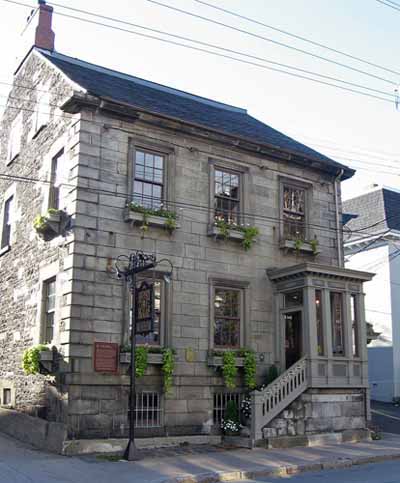Henry House National Historic Site of Canada
Halifax, Nova Scotia

General view
© Parks Canada Agency / Agences Parcs Canada, 2006.
Address :
1222 Barrington Street, Halifax, Nova Scotia
Recognition Statute:
Historic Sites and Monuments Act (R.S.C., 1985, c. H-4)
Designation Date:
1969-05-08
Dates:
-
1834 to 1834
(Construction)
Event, Person, Organization:
-
William A. Henry
(Person)
Other Name(s):
-
Henry House
(Designation Name)
Plaque(s)
Existing plaque: 1222 Barrington Street, Halifax, Nova Scotia
This house was built in 1834 in a suburb of Halifax. Its side hall plan, typical of town houses, and the use of ironstone and granite is representative of the style of many Halifax residences of the early 19th century. The masonry of the gable wall and the surrounds of the windows are Scottish in character. For twenty years it was the home of William A. Henry, Fathern of Confederation, Attorney General of Nova Scotia, Mayor of Halifax and Judge of the Supreme Court of Canada from its inception in 1875 until his death in 1888.
Approved Inscription: Halifax, Nova Scotia
This house, built about 1834, represents an urban house type found in several towns of British North America in the first half of the 19th century. Typically it is three bays wide with a side hall entrance and a truncated gable roof. Its facade is composed of ashlar granite blocks with prominent quoins and its gable walls are roughly dressed in local ironstone. For about fifteen years this residence was the home of William A. Henry (1816-1888), lawyer, politician, Father of Confederation and Judge of the Supreme Court of Canada.
Description of Historic Place
Henry House National Historic Site of Canada is a two-and-a-half-storey stone house built in the early 19th century. Located at the front edge of its lot on the edge of downtown Halifax, Henry House features a gable roof topped by a single side chimney, a portico-covered side entrance, various multi-pane sash windows, and walls of ashlar granite blocks on the façade and dressed rough ironstone on the gable ends. Official recognition consists of the building on its property at the time of designation.
Heritage Value
Henry House was designated a national historic site of Canada in 1969 because: Henry House represents an urban house type found in several towns of British North America in the first half of the 19th century; for about fifteen years this residence was the home of William A. Henry (1816-1888), lawyer, politician, Father of Confederation, and Judge of the Supreme Court of Canada.
In its side hall plan and its granite and ironstone exterior, Henry House is representative of the style of early 19th-century British North American residences built for the elite. In favour of uniting the British North American provinces, and one of five delegates appointed to represent Nova Scotia at the Charlottetown Conference, William A. Henry made this house his residence during the time of Confederation.
Source: Historic Sites and Monuments Board of Canada, Minutes, May 1969.
Character-Defining Elements
The key elements that relate to the heritage value of Henry House are: the composition of its façade, three bays wide with a portico-covered entrance at one side; its gable roof with the long side oriented toward the front elevation; its stone construction, consisting of ashlar granite blocks with prominent quoins along the main façade, and gable walls roughly dressed in local ironstone with granite window surrounds; the craftsmanship evident in the gable wall masonry, and in the ashlar window surrounds; its interior plan, with the first and second floors organized around a side hall with stairs, and kitchen space located in the basement; surviving original interior finishes and fittings, including door and window trims and casings, interior shutters, mouldings, baseboards, six-panel doors, ceiling cornices and medallions, fireplace mantels, and the staircase; its situation at the front edge of its lot, sustaining a close relationship with the street in keeping with its function and design.